Want to check out our tractor maintenance videos? Click here to see what we've got!
This week we have been asked to do an engine rebuild on a Massey Ferguson 35. It has the Standard Motor Company 23C 4 cylinder diesel engine fitted and the serial number puts the date of manufacture at 1959. This engine model is well known by enthusiasts to be difficult to start and this one is no exception. When the owner bought the tractor the starter motor wasn’t fitted so the only way was to tow it off. We had nearly reached the end of the driveway before it started, although admittedly the gravel surface wasn’t ideal.
The gearbox, hydraulics and p.t.o. are all in good working order, although the engine definately needs some attention. The bonnet and instrument panel housing are both straight and sound (rare for a tractor of this age) and so have been sent to the paint shop to be resprayed. The owner is taking the opportunity to rub down and re-paint the whole tractor whilst it is apart. It has all the makings of a quality renovation.
We are having the engine rebuild filmed for a DVD which will be released later in the year. It looks like it’s going to be good viewing weather you are interested to learn how to complete an engine rebuild yourself, or if you are just interested to see the complete renovation take place.
More on this project to come later…….
Read Engine Rebuild – Strip Down
Comments…
1
William Ruck says:March 10th, 2008 at 6:07 am
William Ruck wrote:
Hi there, After purchasing your DVD some time back I have now started the rebuild of my 1958 MF35 with the 23c engine fitted. I have just a few questions to ask if you wouldnt mind answering them for me. How did you clean off and strip paint of the tractor featured in the DVD and also how did you paint the tractor once you had finished it.
>
> Many Thanks
>
> Will2
Vintage Tractor Engineer says:March 10th, 2008 at 6:09 am
Hi William,The tractor didn’t belong to us. We just did the engine and the owner did the paintwork. The bonet was sent away to a paint shop to be properly sprayed, which gave a superb finnish. As far as I know the castings were
just wire brushed, primed and then given the top coat – simple as that (just using a brush). After the primer and the top coat of grey, the gentleman then mixed some good quality thinners into the grey to make the paint a bit thinner and slightly more glossy. He then went over it with this mixture, which helps give a slight shine and also smooths out any slight brush strokes left from the previous coat.Have you rebuilt the engine on your tractor?
Hope that gives you some ideas.
Steve Ridsdale
3
William Ruck says:March 10th, 2008 at 7:10 pm
Hi Steve,I havent finished the engine rebuild yet, I’m just in the middle. I have the engine stripped down awaiting the parts to be sent to put it back together. I found when taking the engine to bits that the timing chain tensioner has the spring missing and was not tensioning the chain so good job I started this when I did before anything big happened. Ive only one problem at the moment im trying to find a way to remove number 2 liner from the block. I really appreciate all your help since I first started to think about rebuilding this tractor and proberly would not have even attempted it without viewing your DVD first.
Again Many Thanks
4
The Vintage Tractor Engineer says:March 10th, 2008 at 7:11 pm
Hi Will,You’ll need to make something to push in from the crankshaft end to be able to push out the liner. It may take quite a lot of force.
Try pouring hot water into the water jacket (or use hot air gun or similar) to expand the block – this may help free it.
If you make a liner removal tool it is best if it has a ledge on it that slides into the liner (sort of a top hat shape) and then the step on the tool will push on the bottom of the liner without slipping off.
It sounds like you’ve started the engine rebuild just in the nick of time with the timing chain tensioner fault.
Steve.
5
Scott Stephenson says:August 20th, 2008 at 5:13 am
I have an engine stand for my engine block. It is certified to 340 kilos. Does anyone know the weight of a 23c engine? My engine incidentally is from an Allis Chalmers ED40.6
Rob Gill says:August 20th, 2008 at 5:25 pm
Hi Scott,
In short I don’t know how much the 23c engine weighs, but the Ferguson FE35 weighs in at just over 1400kg. So I would guess at something approaching 500kg.Rob.
7
Scott Stephenson says:August 21st, 2008 at 7:25 am
Thanks Rob. I put the short engine on the stand yesterday and it’s fine….! Mindyou it is without the head and ancilliaries so just a short block really. I won’t be replacing the head until it’s back on the tractor on it’s wheels though.What would be the best technical publication to assist me with the rebuild. I have an old reprint of a BL(I think) manual from about 73 but think something that reflects newer practice and lessons learnt might be more appropriate.
8
The Vintage Tractor Engineer says:August 21st, 2008 at 7:00 pm
Scott,Other than the BL manual (which should be OK if it gives all the specs etc.) you probably have 3-4 choices I can think of.
1. Is there a manual available for the ED40? (that would be the ideal answer)
2. You can get an I & T Shop service manual for the MF35 for around £20.
3. You can get a genuine Ferguson manual for the ‘35 for around £45.
4. You could get the MF35 Engine Rebuild DVD from this site for around £16.As the early MF35’s had the 4 cylinder 23c engine then these manuals obviously cover this engine. The genuine Ferguson manual is good and in my opinion far superior to any other make of manual. Needless to say my suggestion would be the DVD! ….as it shows you everything you need to know about the 23c engine rebuild at a fraction of the cost of a manual.
Steve – slightly biased!
9
Scott Stephenson says:September 18th, 2008 at 7:52 am
The Maching Mart Engine stand easily takes the weight of the engine without head. It’ll be too springy to work on with the head in place.On a different subject: Which way up should my valve springs go. Close coils to the head or to the rocker arm?

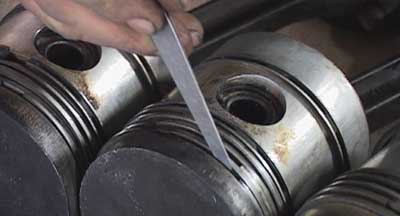
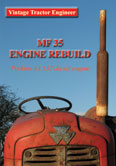
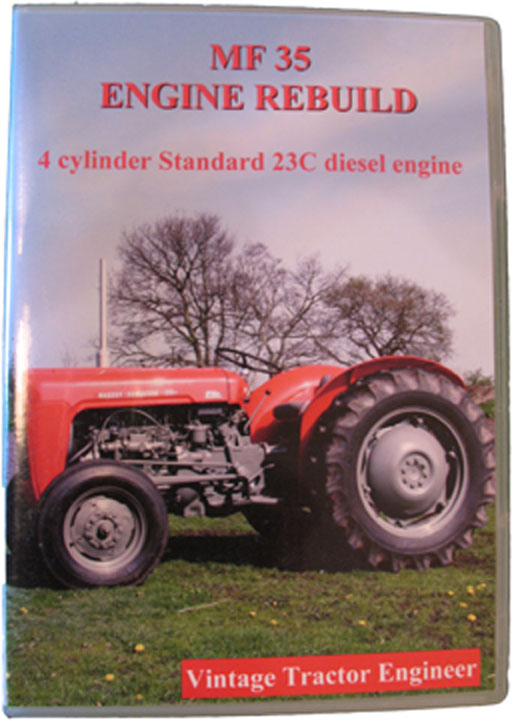
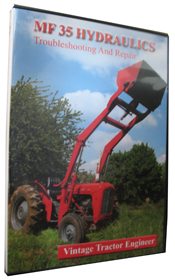
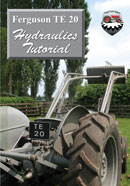
I use Ferguson tractor with the 23c engine on our golf course. The high range low range lever is stuck in high range. I don’t want to go to the expense of buying a a whole manual just for this. Where would I find a diagramme showing what the gearbox is supposed to look like ?